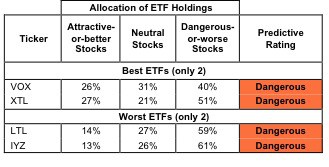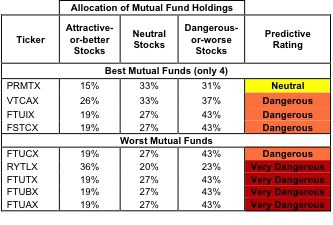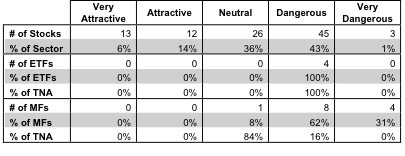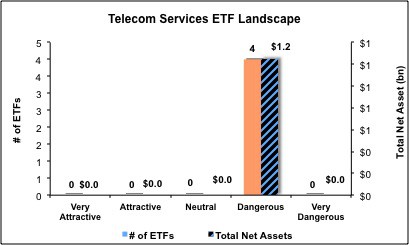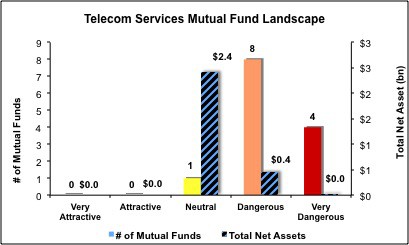The Telecom sector ranks eighth out of the ten sectors as detailed in my Sector Rankings for ETFs and Mutual Funds. It gets my Dangerous rating, which is based on aggregation of ratings of 4 ETFs and 13 mutual funds in the Telecom sector as of October 11, 2012. Prior reports on the best & worst ETFs and mutual funds in every sector and style are here.
Figure 1 ranks from best to worst the four Telecom Services ETFs and Figure 2 ranks from best to worst the nine Telecom Services mutual funds that meet our liquidity standards. Not all Telecom sector ETFs and mutual funds are created the same. The number of holdings varies widely (from 23 to 54), which creates drastically different investment implications and ratings. The best ETFs and mutual funds allocate more value to Attractive-or-better-rated stocks than the worst ETFs and mutual funds, which allocate too much value to Neutral-or-worse-rated stocks.
To identify the best and avoid the worst ETFs and mutual funds within the Telecom sector, investors need a predictive rating based on (1) stocks ratings of the holdings and (2) the all-in expenses of each ETF and mutual fund. Investors need not rely on backward-looking ratings. My fund rating methodology is detailed here.
Investors should not buy any Telecom ETFs or mutual funds because none get an Attractive-or-better rating. If you must have exposure to this sector, you should buy a basket of Attractive-or-better rated stocks and avoid paying undeserved fund fees. Active management has a long history of not paying off.
Get my ratings on all ETFs and mutual funds in this sector on my free mutual fund and ETF screener.
Figure 1: ETFs with the Best & Worst Ratings – Top 2
* Best ETFs exclude ETFs with TNA’s less than $100 million for inadequate liquidity.
Sources: New Constructs, LLC and company filings
SPDR S&P Telecom ETF XTL and ProShares Ultra Telecommunications ProShares LTL have total net assets (TNA) below $100 million and do not meet our liquidity standards but are included because there are only 4 Telecom ETFs.
Figure 2: Mutual Funds with the Best & Worst Ratings
* Best mutual funds exclude funds with TNA’s less than $100 million for inadequate liquidity.
Sources: New Constructs, LLC and company filings
Four funds are excluded from Figure 2 because their total net assets (TNA) are below $100 million and do not meet our liquidity standards.
All Telecom ETFs are rated Dangerous, but Vanguard Telecom ETF VOX is the best of the Dangerous-rated Telecom ETF. T. Rowe Price Media & Telecommunications Fund, Inc. PRMTX is my top-rated Telecom mutual fund. VOX earns my Dangerous rating, while PRMTX earns my Neutral rating.
iShares Dow Jones U.S. Telecommunications Index Fund IYZ is my worst-rated Telecom ETF and Fidelity Select Portfolios: Fidelity Advisor Telecommunications Fund FTUAX is my worst-rated Telecom mutual fund. IYZ earns my Dangerous rating and FTUAX earns my Very Dangerous rating.
Figure 3 shows that 25 out of the 99 stocks (over 20% of the total net assets) held by Telecom ETFs and mutual funds get an Attractive-or-better rating. However, there are not any Attractive-or-better-rated Telecom ETFs or mutual funds.
The takeaway is: mutual fund managers allocate too much capital to low-quality stocks and Telecom ETFs hold poor quality stocks.
Figure 3: Telecom Sector Landscape For ETFs, Mutual Funds & Stocks
As detailed in “Cheap Funds Dupe Investors”, the fund industry offers many cheap funds but very few funds with high-quality stocks, or with what I call good portfolio management.
I recommend that Investors avoid all Telecom ETFs and mutual funds because none of the funds earn an Attractive-or-better rating. If investors still require exposure to the Telecom sector, they should instead focus on owning a basket of Attractive-or-better-rated stocks.
Vonage Holdings VG is one of my favorite stocks held by Telecom ETFs and mutual funds and earns my Very Attractive rating. Vonage is one of only two Very Attractive Telecom stocks and it’s one of my favorite types of companies. Companies like Vonage leverage technology to provide services more efficiently. Not only does Vonage lower the costs of communication for consumers, they do so in a profitable and efficient manner by avoiding the capital intensity of the legacy networks. Vonage’s return on invested capital is the best in the Telecom sector by a wide margin. At 167.2%, VG’s ROIC is amongst the elite value-creating companies. They have been able to achieve this impressive figure by managing their working capital to maximize cash flows. Vonage’s 2011 NOPAT was nearly double its 2009 level. Growing cash flows and surging ROIC indicate that Vonage’s management is disciplined about maximizing shareholder value. The stock is also available at a bargain. The current valuation implies that Vonage’s profits will permanently decline by 62%. Those low expectations make a profitable company like Vonage an attractive buy.
Leap Wireless International LEAP is one of my least favorite stocks held by Telecom ETFs and mutual funds and earns my Very Dangerous rating. LEAP is a consistent value-destroyer and should be avoided by investors who demand a return that is sufficient to compensate them for the use of their capital. LEAP has never earned a ROIC greater than its WACC. While it’s true that LEAP’s NOPAT has slowly grown from 2005’s level of $33.07 million to $116.51 million in 2011, that profit growth has come at a significant cost. LEAPs’ invested capital has grown rapidly as well and their ROIC has never been higher than 3%. Returns that low will likely never generate value for shareholders.
41 stocks of the 3000+ I cover are classified as Telecom stocks, but due to style drift, Telecom ETFs and mutual funds hold 99 stocks.
Figures 4 and 5 show the rating landscape of all Telecom ETFs and mutual funds.
Our Sector Rankings for ETFs and Mutual Funds report ranks all sectors and highlights those that offer the best investments.
Figure 4: Separating the Best ETFs From the Worst ETFs
Figure 5: Separating the Best Mutual Funds From the Worst Mutual Funds
Review my full list of ratings and rankings along with reports on all 4 ETFs and 13 mutual funds in the Telecom sector.
Disclosure: I own VG. I receive no compensation to write about any specific stock, sector or theme.
© 2025 Benzinga.com. Benzinga does not provide investment advice. All rights reserved.
Trade confidently with insights and alerts from analyst ratings, free reports and breaking news that affects the stocks you care about.
